We went to see the whales.
After I left the Journal, I found myself more and more following the McPhee Rule. Whatever it is you loved when you were ten, the author John McPhee once wrote, will likely be your passions for life. When I was ten, I loved whales.
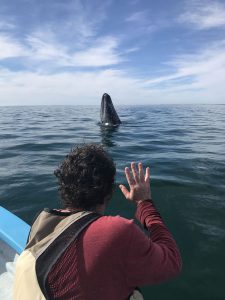
Hey, whale. (Credit: Naomi Levy)
For decades I wanted to go see them mate and spawn in their breeding grounds in Baja California. They travel thousands of miles from their summer feeding grounds off the coast of north Alaska, cruising past Washington, Oregon, California to Baja, where they calve and mate in the placid lagoons.
In the Jacques Cousteau book, Whales — which I read when I was ten — there are photos of people touching the whales in San Ignacio Lagoon. I was not a space travel science fiction kid. Why obsess over the possibility of extraterrestrial life when there are friendly, intelligent species we can commune with here on earth? The ocean to me was the world that needed exploring, and whales were the Martians we could actually meet.
If we didn’t kill them all first.
For centuries men pursued and slaughtered gray whales. Their blubber was rendered into lamp oil. The Atlantic population was hunted to extinction. In Baja in the late 19th century, the whaler Charles Scammon went after the breeding females, turning the blue waters red. His tactic was to harpoon the babies, whose cries of agony would bring the mothers to the surface to protect their young, where more and bigger harpoons awaited them. The mother grays fought back. They attacked the whalers, crashing the boats, sending hundreds of sailors to their deaths. Whalors gave the grays a new name, “Devil Fish.”
The name and reputation stuck even after commercial whaling was banned in 1949. Then, in 1972, a fisherman in San Ignacio, Francisco “Pachico” Mayoral, was out on the lagoon when a whale approached. Instead of fleeing in terror, Pachico let the whale approach. He reached out to touch it, and the whale reached back. It stayed near. An interspecies switch flipped.
“I was surprised at first, even frightened,” he told the environmental group, Guerrero Negro Verde. “But the animal was still, and I felt I had to put my hand in the water, and touch it….since then, I have waited for them every year, they are also my family.”
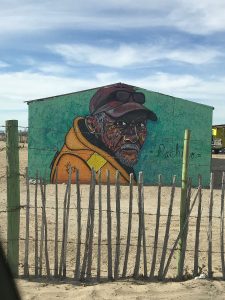
Mural of Pachico in San Ignacio village (Credit: Naomi Levy)
The new relationship led to increased protections. A species on the brink of extinction has rebounded to a population of about 20,000. And whale tourism was born.
To get to San Ignacio Lagoon from Los Angeles, we flew into Loreto. Two hours, Alaska Air, $200, and you’re in a different world. Kind of. Many older Americans have made Loreto their home. A seaside condo costs under $100,000. Food and medicines are cheap. The air is clean and the weather dry and warm. There’s a good hospital in La Paz. Retirees flocked there in the 90’s before the drug wars spiked the murder rate, but as far as I could tell they haven’t budged.
Is it safe? The murder rate in Baja California Sur is up 433 percent this year over last, from 27 homicides in the first quarter of 2016 to 144 this year so far. The violence is largely cartel-directed, and in more populated areas like Cabo San Lucas. Loreto certainly felt safe. But we did see occasional truckloads of armed soldiers, and on the road from Loreto to San Ignacio we had to stop for questioning at an army checkpoint.
“Drogas? Armas? Marijuana?” a young soldier asked me.
I shook my head and we were on our way.
Loreto was the first town successfully established by the Spanish colonizers in Baja. All the missionaries that moved up through California started from Mission Loreto. A small sign marks the beginning of El Camino Real, the royal road that missionaries followed to settle San Diego, Los Angeles, Santa Barbara and other towns. If you were one of the estimated 40,000 – 200,000 Southern California natives (Seri, Yang Na, Chumash, Gabrieleno…) that lived for thousands of years in villages and settlements in pre-contact California, Loreto is Ground Zero for death, destruction and genocide. The missionaries infected, enslaved and all but obliterated native culture in Baja and in what they called Alta California. Our room at the Posada de las Flores looked out on the central square, the launching point for these campaigns. If anything, the colonizing seemed to be going in the opposite direction. Loreto’s economy depends on the tourists and American pensioners we watched milling about below us, shopping for whale watching tours, souvenirs and margaritas.
We ended up having two breakfasts, two dinners and two lunches in Loreto. On the ten minute drive in from the airport the cab driver told me the best breakfast place was Cafe de Ole, just off the main square. He was right. It’s a simple counter service place, almost 40 years old. You order basic food — huevos rancheros, tacos, coffee from an urn– the woman cooks it, you eat it sitting on the warm patio, looking at city hall. A full meal costs about four dollars.
Best for dinner was La Palapa, a block away. There’s a large outdoor kitchen with a wood grill. Fresh fish from the Sea of Cortez– one block away– is grilled or fried to order. It was the one place we saw where upscale locals mixed with tourists and expats, maybe because everybody told us it was the best food in town, or maybe because you could smell the wood smoke from the open grill from blocks away.
If you’ve eaten in Mexico City, Oaxaca or Tijuana lower your expectations about the food in this part of Baja. It is decent and generic. The reason, I think, has something to do with the those missionaries and Baja’s tragic past. The native population was almost obliterated, along with their food ways and their knowledge of local plants and animals. In the late 19th century, the Mexican government encouraged people from the mainland to move to Baja, offering them land if they settled in the depopulated territory. In Oaxaca, native populations survived and passed their cooking into the broader Mexican culture. Whatever unique flavors could have infused Baja cooking died with the Indians.
We rented a car in Loreto and drove four hours northwest to San Ignacio. The bus is cheaper, but it takes six hours, and we wanted to be able to stop along the way.
We followed the Sea of Cortez up the coast. The sky was warm and deep blue. The sea had many colors: aquamarine along the shallows, turquoise where it began to deepen, then azure, where it blended into the sky. To our left was endless desert, red chunks of volcanic rock, pillars of cardon cactus, and jagged mountains in the distance.
After an hour the road arches down toward Bahia Concepcion. The stunning beaches are almost incomprehensibly undeveloped considering how close they are to the United States. Some of the beaches have homes or trailers rented to ex-pat Americans and Canadians, who spend all but the hottest months there. At Bahia El Burro beach, we stopped for fish tacos at Bertha’s.
In the late afternoon, the place was loud with English. The only other customers were post-middle age American women sitting around three long tables, playing card games, drinking brightly colored alcohols. The fish tacos were crisp-battered and delicious, served make-your-own style with little bowls of pico de gallo, crema, avocado and lime. We sat beneath last Sunday’s Super Bowl decorations and stared through a window at the near-tropical beach.
We stopped again at El Requeson beach. It was a deep, quiet inlet with a sandbar that led to a small island. A few campers had set up tents along the shore. We once flew 22 hours to get to Bali, and didn’t find landscapes more beautiful or less touristed.
I had brought a copy of John Steinbeck’s The Log from the Sea of Cortez, his account of a research trip he made there just before World War II with his friend the marine biologist Edward Ricketts. Their boat Western Flyer had anchored for a night in the bay, and when Steinbeck awoke he wrote: “The sun glowing on the morning beach made us feel good. All nature seemed sparkling with life…Everything appeared delightful.'”
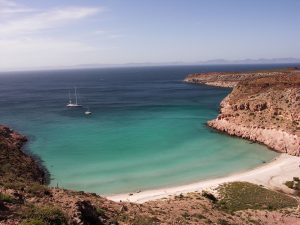
Bahia Concepcion (Credit: Wikimedia Commons)
It’s all beautiful until Santa Rosalia. A Mad Max complex of decaying industry litters the bay here, and the nearby hills are stripped clean of vegetation and littered with garbage. French then Korean mining corporations had descended upon Santa Rosalia and quarried the hills for copper, circumventing environmental laws thanks to corrupt Mexican officials. The unnatural harbor is made from early Industrial Age smelter slag. The view beyond the trash is still stunning.
The road quickly turns west, though, through miles of beautiful, uninterrupted desert. How uninterrupted? The old prison in the nearby town of Mulege never had bars or locks on the cells, and the convicts were allowed to go into town whenever they pleased. Anyone dumb enough to try to escape would die long before reaching civilization.
San Ignacio is on the western coast, the Pacific Ocean side of Baja. The town itself is miniscule. There’s a church from the mid-1700s, a zocalo, some basic shops and restaurants, and the whale-watching office of Ecoturismo Kuyima, which was running our trip.
We stayed the night at San Ignacio Springs Bed and Breakfast, a series of well-appointed yurts along a deep natural pond and small river. I know the pond is deep because on the second day of our trip I dropped my iPhone in it. This is the face of someone who just realized he will no longer have a camera on a whale-watching trip:
There were two restaurants in San Ignacio open that evening. A staffer at Kuyima said they were both pretty much the same, but he happened to be friends with Victor, “so I recommend Victor’s.” We ate at Victor’s.
It’s just across from the church on the town square. The waiter moved our plastic table outside, where several tables of tourists were draining bottles of Modelo and tequila and eating the platters of fish filet in mojo de ajo sauce and enchiladas coming out of the kitchen. The fish was from the lagoon we’d be visiting the next morning, an hour away. We ordered it grilled — a la brasa— with a side of lemon, salsa and guacamole.
For dessert there was a small stand next door with a hand-painted sign promoting Pan Datil y Empanadas de Datil. Date palms seem to be the main agriculture nearby. The daughter was selling what the mother was making. We bought two date empanadas. They were easily the most memorable food of the entire trip. The dough was thin and soft, like a just-cooked butter cookie. A thin layer of date filling was just barely sweet. The daughter told me the only ingredients were butter, flour, sugar and dates. When we returned to San Ignacio on the way back, we tried to buy more empanadas to take home, but were told the stand is only open at night. I still want more.
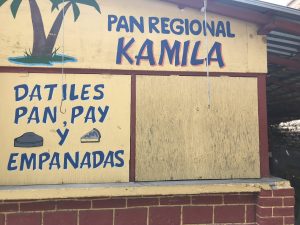
The incomparable date empanadas of San Ignacio. (Credit: Rob Eshman)
The next morning we met the group in the square at 8 am and followed the Kuyima van out to the campsite. The paved road tracks through more desert, then becomes a hard-packed dirt road. It gets bumpy. High tide can bring the sea water up and over the road, carving out ruts and exposing stones. The van leading the way covered our car in thick plumes of salt dust. I kept thinking of the Warren Buffet line: “No one in the history of the world ever washed a rental car.” After an hour we reached the Pacific Coast and San Ignacio Lagoon.
Another name for gray whale is “desert whale.” As oxymorons go it’s right up there with jumbo shrimp. But when you go to San Ignacio to visit, it makes sense. The Baja desert surrounds San Ignacio. Endless miles of rock, sand and cactus come to an end in blue water. Cactus cast their shadows on sea shells. At night coyotes emerge from behind dry rocks to prowl the tide pools.
It was a warm, sunny day. The lagoon was vast, bigger than I imagined, blue and placid against distant jagged mountains. The Kuyima camp is one of only a handful permitted by the ecologically-minded land owners. There are a dozen brightly colored cabins that really should have their own episode of “Tiny House Nation.” Each has two small beds, a closet with a night-use-only marine toilet, a shelf, and three windows facing the lagoon.
The youthful Mexican guides, Sofia and Josue, spent a good 20 minutes of orientation explaining the outhouses. There was one composting toilet for women and men, which we could use for Numbers 1 and 2, an eco-friendly urinal for men only, an outhouse for women for Numbers 1 and 2, and another for men which in my notes I have described as, “Numbers 1 and (maybe) 2.”
The shower was simpler: there was a bucket to fill with cold water and solar-heated water, and a private stall to pour it over your body.
“You’d be surprised how you really don’t need more than one bucket,” Sofia said.
She was right, we didn’t, and I was surprised.
Meals, drinks, games, shmoozing and instructions all took place in the palapa. It was solar powered, so during the day you could charge your cell phone there. That didn’t concern me because A) I had no cell phone and B) there was no cell coverage and no wi-fi.
I hadn’t been off the grid since the iPhone was invented. My initial panic led from intermittent agitation to low level anxiety to mild inconvenience to a deep sense of WTF. It was the five stages of grief in reverse. A week without a cell phone calmed me.
The palapa was also where we would get to know the other guests and the Mexican guides and staff. Sofia, 24, was aiming for a PhD in marine biology. Josue divided his time between the worlds of finance and biology. He organized and led non-whale watching activities, which included a visit to vast natural salt flats, a tour of the local oyster farms, and, afterwards, a pre-dinner snack of grilled oysters with lime and chili.
Getting to know the staff was an unexpected trip highlight. On the small list of things I am grateful to our president for, one would be making conversation with smart, thoughtful Mexicans over delicious food and a couple of Modelos feel like an act of #resistance.
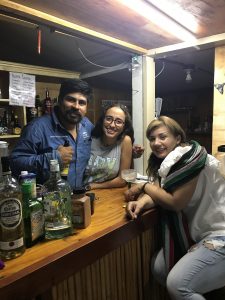
Kuyima staffers Josue (with prop beer), Sofia and Maggie. (Credit: Rob Eshman)
Our first trip out was our first afternoon. We divided into two groups of nine people each and piled into open air skiffs called pangas. A pilot stood in the back handling a big outboard motor. Fifteen minutes later we were in the mouth of the lagoon, the only area where the whale watching boats are allowed. Just sixteen boats are permitted at any one time, and no one boat can stay longer than 90 minutes. Only two boats can linger close to a single whale. The rules are set and enforced by the cooperative of local landowners. They have organized their cooperative around the idea that what is good for the whales and the local ecology is good for the community.
The pilot slowed the boat. Twenty yards away a whale broke the surface. We gasped. These are creatures with bodies the size of jets, slick gray, mottled white and black with barnacles. They dwarf our boats. Nothing on earth prepares you for their combination of hugeness, grace and majesty.
All around us whales are popping out of the water with their massive triangular heads. It’s called spy-hopping, and biologists believe it’s what these air-breathers do to take a good look around. Sometimes they breach, clearing the water with their massive bodies and landing with a great splash. And other times they dive, and we see their heart-like flukes appear and disappear.
They got close enough, often, so that we could stare directly at them, and they at us. Their eyes are large, shiny and black. When our eyes met it was impossible not to feel some sort of interspecies communication. Eye to eye. Heart to heart.
Sometimes they come close enough to touch. It’s forbidden to approach marine mammals in the United States, but in San Ignacio, if the whales initiate or allow the contact, it’s permitted. Usually it is mothers with their babies who come close enough. Our guides explained that it may be they just are curious about humans, or it could be the females feel safer near the boats, knowing that the males won’ t approach them for courtship as long as the boats are nearby. The males are known to be impatient. To mate with the moms, they will slap the gray whale babies with their tails, occasionally killing them.
Touching is what we hope for, too. But it’s not as common as YouTube videos or my old Jacques Cousteau book would have you believe. The whales come into the lagoon from January through March, but they get cozy with the boats for just a portion of that time.
Several moms and babies approached our boat. On the third day of our trip, I leaned over the bow as a mom approached. I reached down. She broke the surface. I stretched. My hand grazed her slick back. It was slippery and giving. The people on a nearby boat saw my touch and broke into applause.
I was reading another book on the trip, one I found in the library of the palapa. Dick Russell’s Eye of the Whale is the finest journalistic account of gray whale biology and history. Russell came to San Ignacio, to Kuyima camp. He investigated the battle that Mexican activists and the US-based Natural Resource Defense Council fought and won to keep Mitsubishi from turning San Ignacio into a massive salt factory.
After tracking them from the Bering Sea to Baja, he sumarized what it means that these wild animals, which we humans once slaughtered mercilessly, now choose to meet us:
“Imagine…What if lions in the jungle suddenly allowed you to pet them? What if elephants suddenly slept at your feet. The Mexicans say the gray whales are ‘tame.’ Yet they are not domesticated. We did not “break” them as we might a horse. They tamed themselves, to come to us their time-honored enemy, in the place where they give birth. And mysteriously, it feels like this is how it should be, how it used to be. The commonality is primordial. We are molded of the same clay. Eschritius robutus. Homo sapiens.”
That’s exactly how it felt. We went out to see the whales four times. And we only wanted to stay out, and then go back. And it wasn’t just because I’d been wanting to see them in San Ignacio since I was ten. It wasn’t just the completion of a childhood dream. It was because seeing them alters the way you see everything. And it’s not easy to put into words, but looking them in the eye, you can’t not feel it. The last day, lying in our tiny cabin, I finished The Log from the Sea of Cortez. And in a passage near the end, Steinbeck said it best:
“It is a strange thing that most of the feeling we call religious,” Steinbeck writes, “most of the mystical outcrying, which is one of the prized and used and desired reactions of our species, is really the understanding and the attempt to say that man is related to the whole thing, related inextricably to all reality, known and unknowable.”